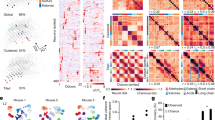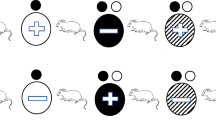Abstract
In their natural environment, animals often make decisions based on abstract relationships among multiple stimulus representations. Humans and other primates can determine not only whether a sensory stimulus differs from a remembered sensory representation, but also how they differ along a particular dimension. However, much remains unknown about how such relative comparisons are made, and which species share this capacity, in part because most studies of sensory-guided decision making have utilized instrumental tasks in which choices are based on very simple stimulus–response associations. Here, we used a two-stimulus-interval discrimination task to test whether rats could determine how two sequentially presented stimuli were related along the dimension of odor quality (i.e., what the stimulus smells like). At a central port, rats sampled and compared two odor mixtures that consisted of spearmint and caraway in different ratios, separated by a 2–4-s interval, and then entered the left or right reward port. Water was delivered at the left if the first mixture consisted of more spearmint than the second did, and at the right otherwise. We found that the difference in mixture ratio predicted choice accuracy. Control experiments suggest that rats were indeed basing their choices on a comparison of odor quality across mixtures and were not using associative strategies. This study is the first demonstration of the use of a sequential “more than versus less than” rule in rats and provides a well-controlled paradigm for studying abstract comparisons in a rodent model system.




Similar content being viewed by others
References
Blaisdell AP, Sawa K, Leising KJ, Waldmann MR (2006) Causal reasoning in rats. Science 311:1020–1022. doi:10.1126/science.1121872
Brown CW, Ghiselli EE (1938) Subcortical mechanisms in learning. IV. Olfactory discrimination. J Comp Psychol 26:109–120. doi:10.1037/h0062529
Bull AR, Cuddy LL (1972) Recognition memory for pitch of fixed and roving stimulus tones. Percept Psychophys 11:105–109. doi:10.3758/BF03212696
Davis H (1996) Underestimating the rat’s intelligence. Cogn Brain Res 3:291–298
Davis H, Perusse R (1988) Numerical competence in animals: definitional issues, current evidence, and a new research agenda. Behav Brain Sci 11:561–579. doi:10.1017/S0140525X00053437
Doty RL (1986) Odor-guided behavior in mammals. Experientia 42:257–271
Dusek JA, Eichenbaum H (1997) The hippocampus and memory for orderly stimulus relations. Proc Natl Acad Sci USA 94:7109–7114
Dwyer DM, Starns J, Honey RC (2009) “Causal reasoning” in rats: a reappraisal. J Exp Psychol Anim Behav Process 35:578–586. doi:10.1037/a0015007
Eayrs JT, Moulton DG (1960) Studies in olfactory acuity: I. Measurement of olfactory thresholds in the rat. Q J Exp Psychol 12:90–98
Erlich JC, Bialek M, Brody CD (2011) A cortical substrate for memory-guided orienting in the rat. Neuron 72:330–343. doi:10.1016/j.neuron.2011.07.010
Felsen G, Mainen ZF (2008) Neural substrates of sensory-guided locomotor decisions in the rat superior colliculus. Neuron 60:137–148. doi:10.1016/j.neuron.2008.09.019
Giurfa M, Zhang S, Jenett A, Menzel R, Srinivasan MV (2001) The concepts of ‘sameness’ and ‘difference’ in an insect. Nature 410:930–933. doi:10.1038/35073582
Herman LM, Gordon JA (1974) Auditory delayed matching in the bottlenose dolphin. J Exp Anal Behav 21:19–26. doi:10.1901/jeab.1974.21-19
Hernández A, Salinas E, García R, Romo R (1997) Discrimination in the sense of flutter: new psychophysical measurements in monkeys. J Neurosci 17:6391–6400
Jaramillo S, Zador AM (2011) The auditory cortex mediates the perceptual effects of acoustic temporal expectation. Nat Neurosci 14:246–251. doi:10.1038/nn.2688
Jennings JW, Keefer LH (1969) Olfactory learning set in two varieties of domestic rat. Psychol Rep 24:3–15
Katz JS, Wright AA, Bachevalier J (2002) Mechanisms of same-different abstract-concept learning by rhesus monkeys (Macaca mulatta). J Exp Psychol Anim Behav Process 28:358–368. doi:10.1037/0097-7403.28.4.358
Linster C, Johnson BA, Yue E et al (2001) Perceptual correlates of neural representations evoked by odorant enantiomers. J Neurosci 21:9837–9843
Lu XC, Slotnick BM, Silberberg AM (1993) Odor matching and odor memory in the rat. Physiol Behav 53:795–804
Mclaren IPL, Mackintosh NJ (2002) Associative learning and elemental representation: II. Generalization and discrimination. Animal Learn Behav 30:177–200. doi:10.3758/BF03192828
Mountcastle V, Steinmetz M, Romo R (1990) Frequency discrimination in the sense of flutter: psychophysical measurements correlated with postcentral events in behaving monkeys. J Neurosci 10:3032–3044
Munn NL (1950) Handbook of psychological research on the rat: an introduction to animal psychology. Houghton Mifflin, Oxford
Murphy RA, Mondragón E, Murphy VA (2008) Rule learning by rats. Science 319:1849–1851. doi:10.1126/science.1151564
Peña T, Pitts RC, Galizio M (2006) Identity matching-to-sample with olfactory stimuli in rats. J Exp Anal Behav 85:203–221
Pfaffmann C, Goff WR, Bare JK (1958) An olfactometer for the rat. Science 128:1007–1008. doi:10.1126/science.128.3330.1007
Reznikova Z, Ryabko B (2011) Numerical competence in animals, with an insight from ants. Behaviour 148:405–434. doi:10.1163/000579511X568562
Romo R, Salinas E (2003) Flutter discrimination: neural codes, perception, memory and decision making. Nat Rev Neurosci 4:203–218. doi:10.1038/nrn1058
Romo R, Brody CD, Hernandez A, Lemus L (1999) Neuronal correlates of parametric working memory in the prefrontal cortex. Nature 399:470–473. doi:10.1038/20939
Rubin BD, Katz LC (2001) Spatial coding of enantiomers in the rat olfactory bulb. Nat Neurosci 4:355–356. doi:10.1038/85997
Rutte C, Taborsky M (2007) Generalized reciprocity in rats. PLoS Biol 5:e196. doi:10.1371/journal.pbio.0050196
Slotnick B (2001) Animal cognition and the rat olfactory system. Trends Cogn Sci 5:216–222. doi:10.1016/S1364-6613(00)01625-9
Slotnick BM, Katz HM (1974) Olfactory learning-set formation in rats. Science 185:796–798
Slotnick BM, Nigrosh BJ (1974) Olfactory stimulus control evaluated in a small animal olfactometer. Percept Mot Ski 39:583–597
Smith JD, Beran MJ, Couchman JJ, Coutinho MVC (2008) The comparative study of metacognition: sharper paradigms, safer inferences. Psychon Bull Rev 15:679–691
Swann HG (1933) The function of the brain in olfaction. I. Olfactory discrimination and an apparatus for its test. J Comp Psychol 15:229–241. doi:10.1037/h0074623
Uchida N, Mainen ZF (2003) Speed and accuracy of olfactory discrimination in the rat. Nat Neurosci 6:1224–1229. doi:10.1038/nn1142
Uchida N, Mainen ZF (2007) Odor concentration invariance by chemical ratio coding. Front Syst Neurosci 1:3. doi:10.3389/neuro.06.003.2007
Washburn DA, Rulon MJ, Gulledge JP (2004) A new breed of computer users: rats control a cursor via joystick manipulation. Behav Res Methods Instrum Comput 36:173–179. doi:10.3758/BF03195562
Weinstein B (1941) Matching-from-sample by rhesus monkeys and by children. J Comp Psychol 31:195–213
Zhang J-Y, Kuai S-G, Xiao L-Q et al (2008) Stimulus coding rules for perceptual learning. PLoS Biol 6:e197. doi:10.1371/journal.pbio.0060197
Acknowledgments
We thank the employees of the Center for Comparative Medicine for the care they provided for the rats. We thank Drs. Carlos Brody, Andrew Barron, Elizabeth Stubblefield, John Thompson, and Nicolas Busquet for their invaluable comments on an initial draft of the manuscript. We thank Jamie Costabile for technical support during this work. This work was supported by the National Institutes of Health, grant 5T32NS007083 (Clint Perry); and the Boettcher Foundation Webb-Waring Biomedical Research Award (Gidon Felsen).
Conflict of interest
The authors declare that they have no conflict of interest.
Ethical standards
The experiments comply with the current laws of the country in which experiments were performed.
Author information
Authors and Affiliations
Corresponding author
Rights and permissions
About this article
Cite this article
Perry, C., Felsen, G. Rats can make relative perceptual judgments about sequential stimuli. Anim Cogn 15, 473–481 (2012). https://doi.org/10.1007/s10071-012-0471-4
Received:
Revised:
Accepted:
Published:
Issue Date:
DOI: https://doi.org/10.1007/s10071-012-0471-4




